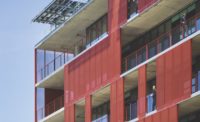On Thursday contractors plan to top out a seven-story, 28-unit apartment building known as the Stack on an infill site in Upper Manhattan. The event would be unremarkable, except that four weeks ago, the only part of the structure that had been erected on the 50-foot-wide by 150-foot-long lot was the first floor framing. Now it is completely enclosed, and has its interior partitions as well as plumbing fixtures, countertops, doors, and hardware—even the toilet paper dispensers have been installed. The Stack, designed by architecture firm Gluck+ (formerly Peter Gluck and Partners), has gone up so quickly because it is composed of 56 steel-and-concrete modules built in a factory in Berwick, Pennsylvania. These components, which make up the studio, one-, two-, and three- bedroom apartments, have been trucked to the site with all interior finishes in place and stacked by crane at the rate of about four per day since June 19.
Developers Kim Frank and Jeffrey Brown say the Stack is New York City’s tallest residential structure relying on off-site construction (the term the project team prefers over “modular” or “prefabricated”)—at least until a 32-story apartment building at the Atlantic Yards site in Brooklyn, designed by SHoP Architects and developed by Forest City Ratner Companies, is complete next summer. (That project is under construction but faces a legal challenge from two trade unions.)
At Atlantic Yards, SHoP has chosen not to make the tower’s unusual construction method visible on its exterior. But Gluck+ decided to express the Stack’s modules on its street-facing facade, by pulling some forward and pushing others back several feet, to create terraces and overhangs. The modules are ideally suited for this treatment, since each has its own frame made of Vierendeel trusses says Marc Gee, a Gluck+ principal.
Before tenants can move in, contractors will need to “zip up” the building. The process includes welding and bolting the modules to each other, making vertical and horizontal connections between already in place ducts, piping, and conduit, and installing the concrete facade panels over 1-inch girts.
The architect and developer estimate that a similar but conventionally constructed building would have cost 15 percent more. And if the Stack stays on track for its expected completion in October, construction will have lasted just under a year—between two and six months less than typical methods, they say. The original target was even more ambitious—the team had hoped to complete the building in less than nine months, but a lengthier than expected review by the department of buildings delayed the start of the stacking process. “It is still construction,” says Gee. “So things happen."







